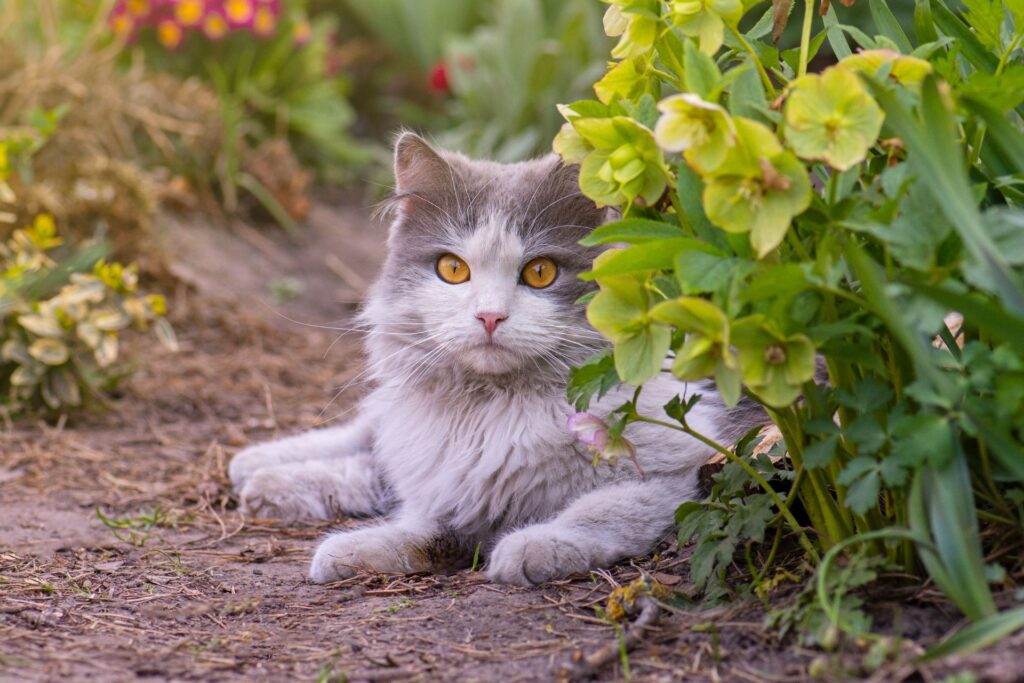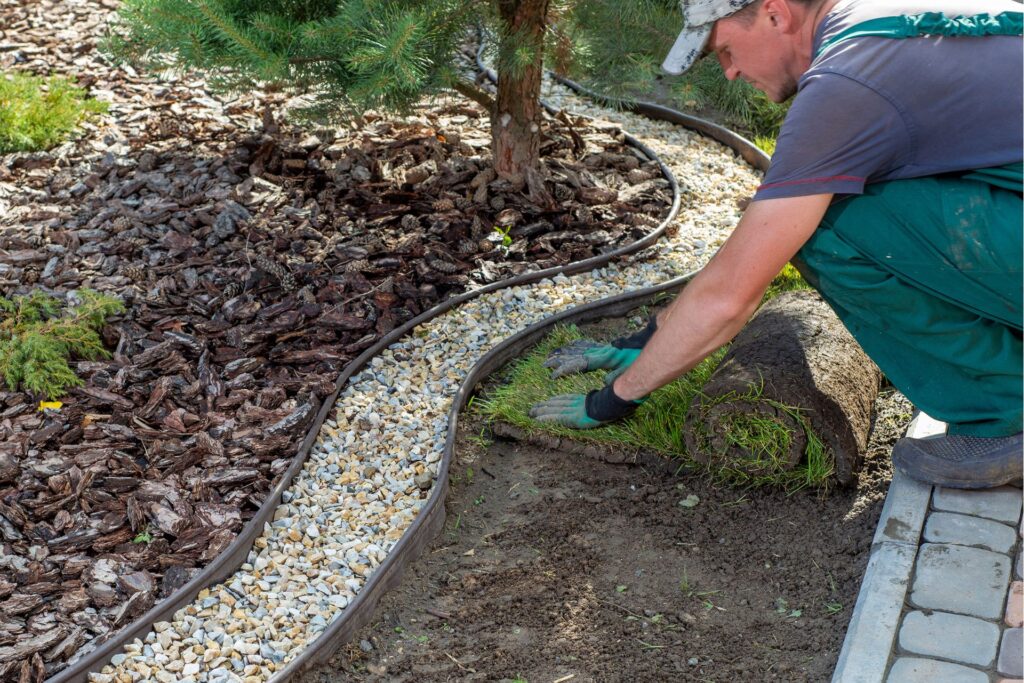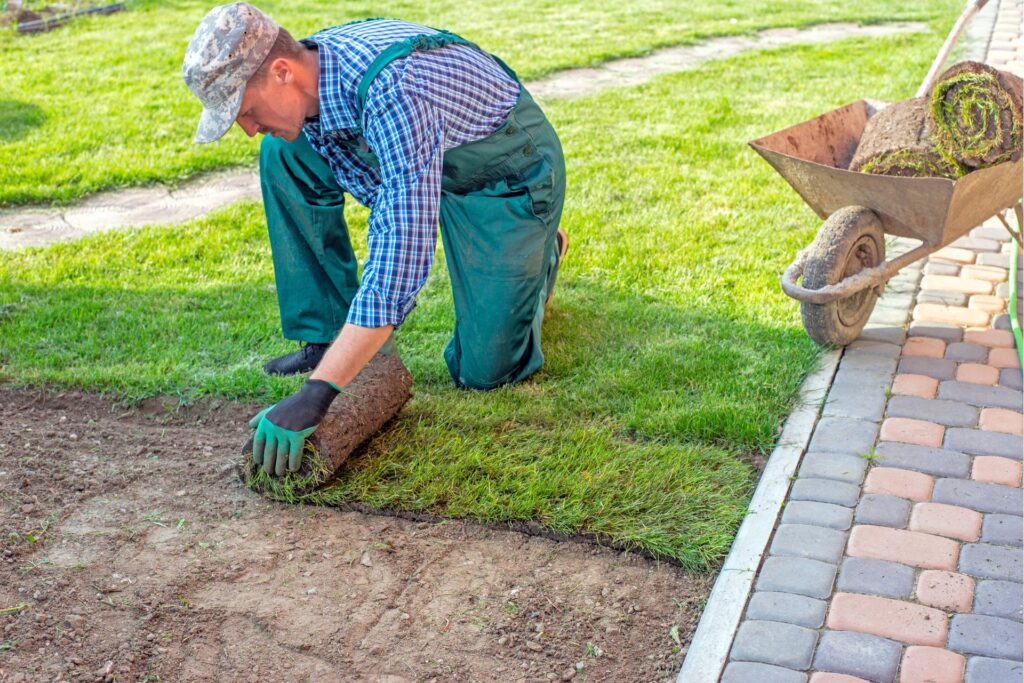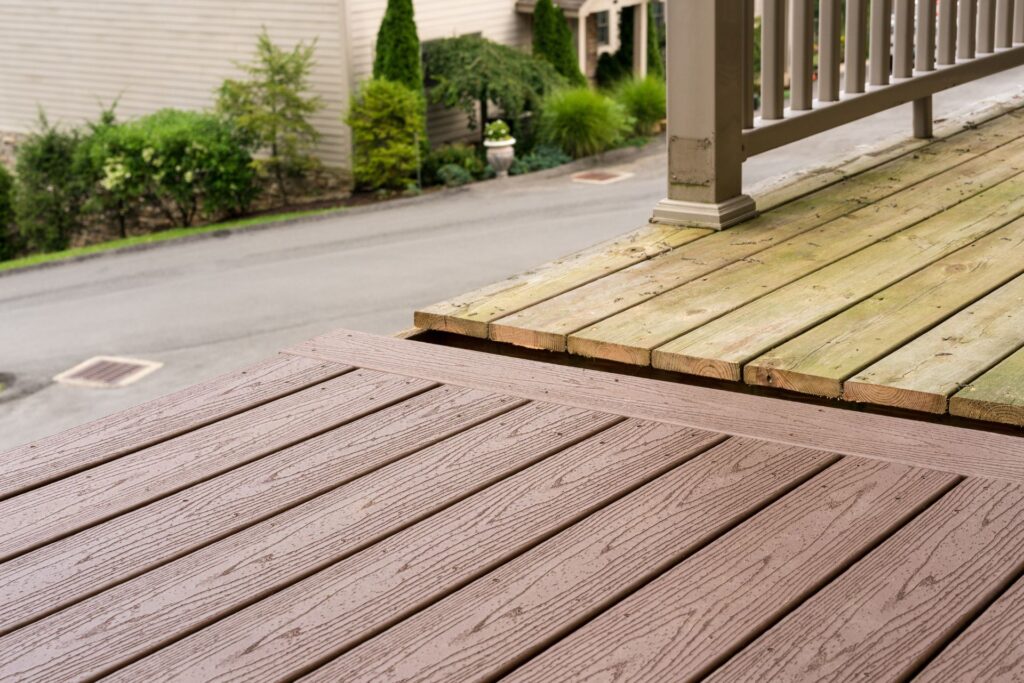Welcome to our guide on how to keep cats out of your garden! Whether you’re a seasoned gardener or just starting, finding your carefully tended plants dug up or trampled by neighborhood cats can be incredibly frustrating. In this post, we’ll explore practical, humane, and effective methods to protect your garden from these curious felines. From natural deterrents to physical barriers and creating cat-friendly zones, we’ll provide you with a comprehensive approach to keep your garden flourishing and cat-free. So, let’s dive in and discover how you can maintain a beautiful, undisturbed garden while keeping our furry friends at bay.
To keep cats out of your garden, use natural deterrents like planting lavender, rosemary, or rue, which cats dislike. Install physical barriers such as low fences or netting to protect specific areas. You can also use homemade sprays with citrus or vinegar to repel them. Motion-activated sprinklers and ultrasonic devices can deter cats without harm. Additionally, create a designated cat-friendly zone with attractive features like catnip and a sandbox to divert their attention from your garden. Regular maintenance and rotating deterrent methods will ensure long-term success in keeping your garden cat-free.
Understanding The Problem
Gardens are often a source of pride for homeowners, offering a space of tranquility, beauty, and sometimes a bounty of home-grown produce. However, for many, maintaining a garden can become a frustrating endeavor due to the uninvited presence of cats. To effectively manage this issue, it’s essential to understand why cats are drawn to gardens and the common problems they cause.
Why Cats Are Attracted to Gardens
Soft Soil for Digging
One of the primary reasons cats are attracted to gardens is the soft soil. Gardens provide a perfect environment for digging, which cats enjoy for several reasons. The soil is easy to manipulate, making it an ideal place for cats to bury their waste or simply enjoy a dig. This natural behavior, while instinctual for cats, can lead to significant disturbances in the garden bed.
Plants They Find Appealing
Certain plants can be incredibly appealing to cats. Catnip, for instance, is notorious for attracting felines, but other plants such as valerian and mint can also draw them in. Cats may rub against, chew on, or lay in these plants, causing damage and stress to the vegetation. Additionally, some cats are attracted to the scent of fresh herbs and flowers, which can lead them to spend more time in your garden.
Safe, Quiet Places to Hide and Rest
Gardens often provide a haven of safety and solitude for cats. The dense foliage and hidden corners offer perfect spots for cats to hide from predators or just take a peaceful nap. The quiet and relatively undisturbed environment of a garden is a sanctuary for cats looking to escape the hustle and bustle of more populated areas.
Common Issues Caused by Cats in Gardens
Damage to Plants and Seedlings
Cats can cause significant damage to garden plants and seedlings. Their playful nature or simple curiosity can lead to broken stems, uprooted plants, and trampled flower beds. For gardeners, this can be incredibly frustrating, especially when it comes to delicate seedlings that have yet to establish themselves.
Soil Disturbance and Digging
Beyond simply walking through the garden, cats often engage in digging. This behavior can disturb the soil structure, displace plants, and disrupt the careful arrangement of the garden bed. For those cultivating a vegetable garden, this can mean lost crops and a setback in growth.
Leaving Droppings and Potential Health Risks
One of the most concerning issues is the droppings that cats leave behind. Not only is this unsightly and unpleasant, but it can also pose health risks. Cat feces can contain parasites and bacteria, such as Toxoplasma gondii, which can be harmful to humans, particularly pregnant women, and individuals with weakened immune systems. Managing this aspect of feline intrusion is critical for maintaining a healthy and enjoyable garden space.
In conclusion, while cats can be charming companions, their presence in gardens often leads to several challenges. Understanding their attraction to these green spaces and the specific issues they cause is the first step in developing effective strategies to protect your garden. By addressing these factors, you can create a more harmonious balance between your love for gardening and the presence of neighborhood felines.
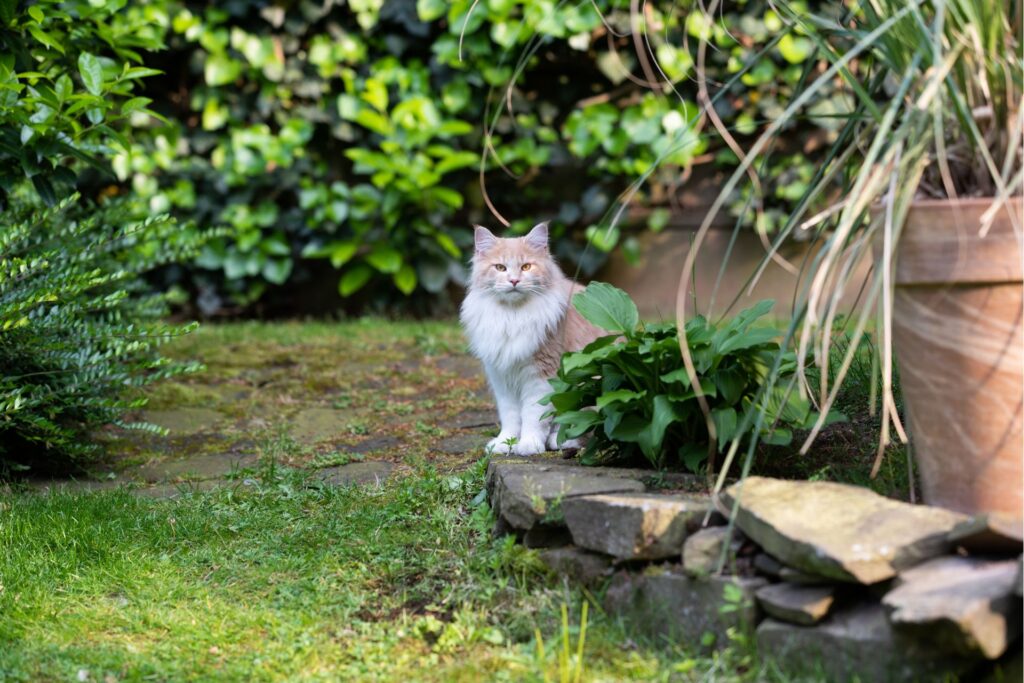
Natural Deterrents
When it comes to keeping cats out of certain areas of your garden or yard, natural deterrents can be both effective and environmentally friendly. Here are some proven methods to consider:
Plants that Repel Cats
Certain plants can act as natural cat repellents due to their scent, texture, or taste. Here are three popular choices:
Lavender
Lavender is known for its strong, pleasant fragrance, which is beloved by humans but disliked by cats. The essential oils in lavender contain compounds like linalool and linalyl acetate, which are effective in repelling cats. Planting lavender around the borders of your garden or in pots near entryways can help keep cats at bay.
Rosemary
Rosemary is another aromatic herb that cats tend to avoid. Its woody scent is not appealing to them. Additionally, the texture of rosemary plants can be a deterrent, as cats prefer softer foliage. Place rosemary plants in strategic locations around your garden to create a natural barrier.
Rue
Rue is a lesser-known plant with cat-repelling properties. Its strong, bitter smell is off-putting to cats, and it contains alkaloids that can cause mild irritation if ingested, further discouraging cats from frequenting areas where it is planted. Rue is often used in herbal gardens and can be a great addition to your natural deterrent strategy.
By incorporating these plants into your garden design, you can create a less inviting environment for cats without using harsh chemicals.
Homemade Sprays and Solutions
In addition to plants, homemade sprays and solutions can be effective in deterring cats from specific areas. Here are a couple of recipes you can try:
Citrus Sprays
Cats generally dislike the smell of citrus fruits like oranges, lemons, and limes. You can make a simple citrus spray by mixing equal parts of water and citrus juice in a spray bottle. For added potency, include a few drops of citrus essential oil. Spray this solution around areas you want to protect, such as garden beds, patio furniture, or doorways. Reapply the spray every few days, especially after rain.
Vinegar Solutions
Another effective homemade cat repellent is a vinegar solution. Mix one part white vinegar with one part water in a spray bottle. Vinegar has a strong, pungent odor that cats find unpleasant. Spray the solution around the perimeter of your garden, on plant pots, or on surfaces where cats tend to roam. Be cautious when using vinegar near plants, as it can affect soil pH and plant health if overused. Reapply as needed, typically every few days or after it rains.
Application Tips
- When applying these sprays, it’s important to target areas where cats frequently visit.
- Reapply the sprays regularly, as their effectiveness diminishes over time and with exposure to the elements.
- Test a small area first to ensure that the solution does not harm plants or surfaces.
By using these natural deterrents, you can create an environment that is less attractive to cats, helping to protect your garden and outdoor spaces without resorting to harmful chemicals.
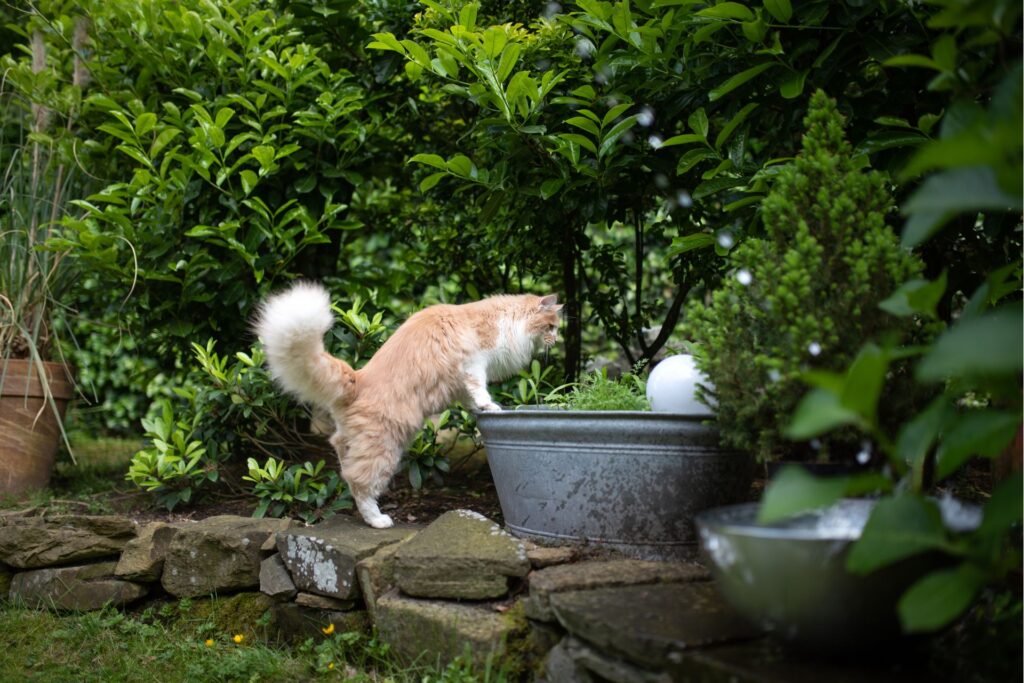
Physical Barriers
When it comes to keeping cats out of certain areas of your garden, physical barriers can be highly effective. Here, we’ll delve into two main types of physical barriers: fencing and netting, and mulching and ground covers.
Fencing and Netting
Types of Fencing Suitable for Keeping Cats Out
Fencing can be a reliable way to prevent cats from entering your garden or yard. Here are some types of fencing that work well:
1. Cat-Proof Fencing: This type of fencing is designed specifically to keep cats in or out of an area. It typically includes features like a curved top that cats can’t climb over or net attached to the top of an existing fence to extend its height.
2. Electric Fences: While more extreme, electric fences can be an effective deterrent. They deliver a mild shock that is unpleasant but not harmful to cats, teaching them to avoid the area.
3. Chicken Wire: Simple and cost-effective, chicken wire can be used to create barriers around specific plants or areas. It’s easy to install and can be shaped to fit various needs.
How to Install Netting Over Specific Areas
Netting is another useful tool for keeping cats away from certain parts of your garden. Here’s how you can install it effectively:
1. Identify the Area: Determine which areas need protection. Common spots include vegetable patches, flower beds, or koi ponds.
2. Select the Right Netting: Choose a durable, weather-resistant netting with small enough holes to prevent cats from slipping through. Garden netting or bird netting often works well.
3. Install Stakes or Poles: Place stakes or poles around the perimeter of the area you want to protect. The height of the poles should be sufficient to keep the netting taut and prevent cats from jumping over.
4. Attach the Netting: Secure the netting to the stakes using zip ties or clips. Make sure it’s tight and there are no gaps where a cat could sneak through. For extra security, bury the bottom edge of the netting a few inches into the ground.
Mulching and Ground Covers
Using Prickly Mulch and Pinecones
Cats dislike walking on uncomfortable surfaces. Using prickly mulch and pinecones can deter them from entering certain areas:
1. Prickly Mulch: Materials like pine needles, thorny clippings, or other sharp-edged mulches can be spread over garden beds. The discomfort of walking on these surfaces will encourage cats to stay away.
2. Pinecones: Scatter pinecones around the base of plants or in garden beds. Their sharp points make it unpleasant for cats to walk over them, acting as a natural deterrent.
Other Ground Covers That Deter Cats
In addition to prickly mulch and pinecones, there are other ground covers that can help keep cats at bay:
1. Stone or Gravel: Cats prefer soft surfaces for walking and digging. Using coarse gravel or small stones can make your garden less appealing to them.
2. Citrus Peels: Cats dislike the smell of citrus. Placing citrus peels (like those from oranges, lemons, or limes) around your garden can help deter them. Just be sure to replace the peels regularly as they decompose.
3. Coffee Grounds: The strong scent of coffee grounds can also repel cats. Sprinkle used coffee grounds around plants and garden beds. As an added benefit, coffee grounds are good for the soil and can improve its quality.
By implementing these physical barriers, you can create a garden environment that is less attractive to cats, helping to keep your plants and outdoor spaces safe from feline intrusions.
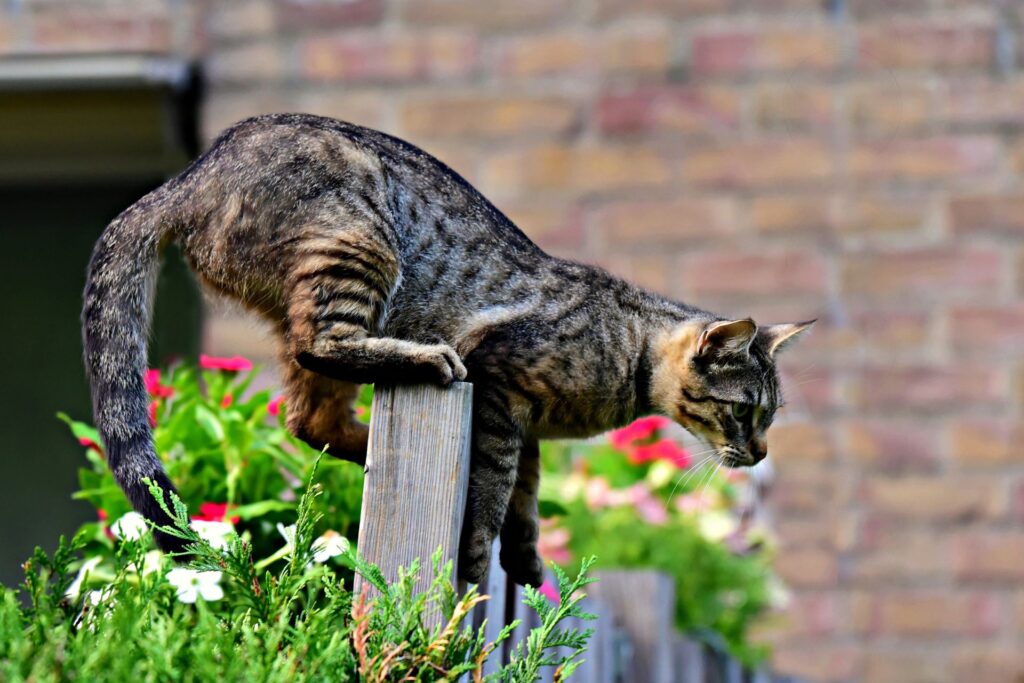
Behavioral Training And Deterrents
Using Water
One of the most effective and humane ways to deter unwanted animals from entering your garden or property is by using water. Water-based deterrents can be both automated and manual, providing flexible solutions for different scenarios.
Sprinklers with Motion Sensors
Motion-activated sprinklers are an excellent choice for keeping animals at bay. These devices detect movement and release a burst of water, startling the animal without causing any harm. The sudden spray of water conditions animals to associate your yard with this unpleasant surprise, encouraging them to stay away. This method is particularly effective for larger areas and can cover a significant portion of your garden or lawn.
Manual Spraying and Water Pistols
For a more hands-on approach, manual spraying with a hose or using water pistols can also be effective. This method is suitable for smaller areas or specific spots where animals tend to frequent. By consistently spraying intruding animals, you reinforce the message that they are not welcome. Over time, animals will learn to avoid these areas, resulting in a pet-free zone.
Sound and Light Devices
Using sound and light to deter animals is another effective strategy. These devices exploit animals’ heightened senses to create an environment they find uncomfortable or threatening.
Ultrasonic Devices
Ultrasonic deterrents emit high-frequency sounds that are unpleasant for animals but typically inaudible to humans. These devices are effective against a variety of animals, including dogs, cats, and even rodents. When placed strategically around your property, ultrasonic devices can create a perimeter that animals find difficult to cross. It’s a non-invasive and maintenance-free way to keep your garden free from unwanted visitors.
Motion-Activated Lights
Motion-activated lights serve as a great deterrent for nocturnal animals. The sudden flash of light startles them and disrupts their natural behavior patterns. These lights can be installed around your property’s perimeter, particularly in areas that animals frequent. In addition to deterring animals, motion-activated lights also provide added security for your home, making them a dual-purpose investment.
By incorporating these behavioral training and deterrent methods, you can effectively manage and protect your property from unwanted animal intrusions. Each method offers a humane and non-harmful solution, ensuring both your peace of mind and the well-being of the animals.
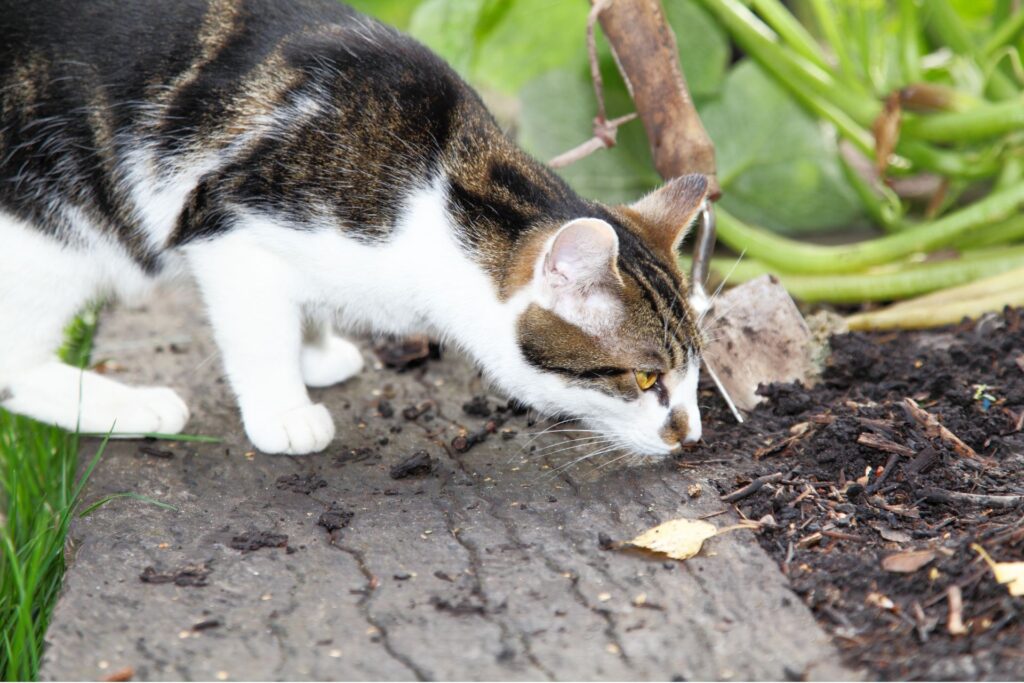
Creating A Cat-Friendly Zone Away From Your Garden
Having a beautiful garden can be one of the joys of home ownership, but it can be a challenge to maintain if you have cats that love to dig and play in your carefully tended beds. Instead of constantly battling with your feline friends over garden territory, why not create a designated cat-friendly zone that will keep them entertained and happy, and out of your flower beds?
Designing a Cat-Friendly Area
A dedicated space for your cats can be both functional and fun. Here’s how to design a zone that will capture their interest and keep them away from your precious plants.
Safe Zones with Catnip and Toys
Cats are naturally curious and playful, and they need stimulation to stay happy and healthy. A cat-friendly area should include safe zones with catnip plants and a variety of toys. Catnip, a herb from the mint family, is known to have a euphoric effect on cats, making it an irresistible attraction. Planting catnip in pots or directly in the ground in the designated area can help lure them away from your garden.
In addition to catnip, provide an array of toys that will engage your cat’s hunting instincts. This can include dangling feathers, balls, and interactive toys that will keep them entertained for hours. Rotate the toys regularly to keep the area interesting and fun for your feline friends.
Providing an Alternative Digging Area (e.g., Sandbox)
Cats love to dig, and this can be a big problem for gardeners. To address this, create an alternative digging area in your cat zone. A simple sandbox filled with soft, clean sand can be an ideal solution. The sandbox will not only provide a place for your cat to dig but also help to keep their claws healthy.
Place the sandbox in a shaded area to make it more appealing during hot weather. You can also add a cover to keep the sand clean and free from debris when not in use.
Attracting Cats to the Alternative Area
Once you’ve designed the cat-friendly zone, the next step is to attract your cats to this new area. Here are some tips on making the designated space more appealing than your garden.
Tips on Making the Designated Area More Appealing
1. Scent Marking: Cats rely heavily on their sense of smell. Attract them to the new area by placing some of their favorite scents in the zone. You can use items they’ve already marked with their scent or sprinkle some catnip around.
2. Comfort and Shelter: Ensure the area is comfortable and offers shelter. Add a few cat houses or shaded spots where they can rest and relax. This will make the area more inviting, especially during extreme weather conditions.
3. Regular Interaction: Spend time with your cats in the new area. Play with them using their favorite toys and give them treats to create positive associations with the space.
4. Visual Stimulation: Cats love to observe their surroundings. Place the cat zone where they can watch birds, butterflies, or other interesting sights without being a nuisance to the wildlife.
By creating a dedicated cat-friendly zone and making it more appealing than your garden, you can redirect their attention and keep both your plants and your pets happy. This approach not only protects your garden but also enhances the well-being of your cats by providing them with a stimulating and enjoyable environment.
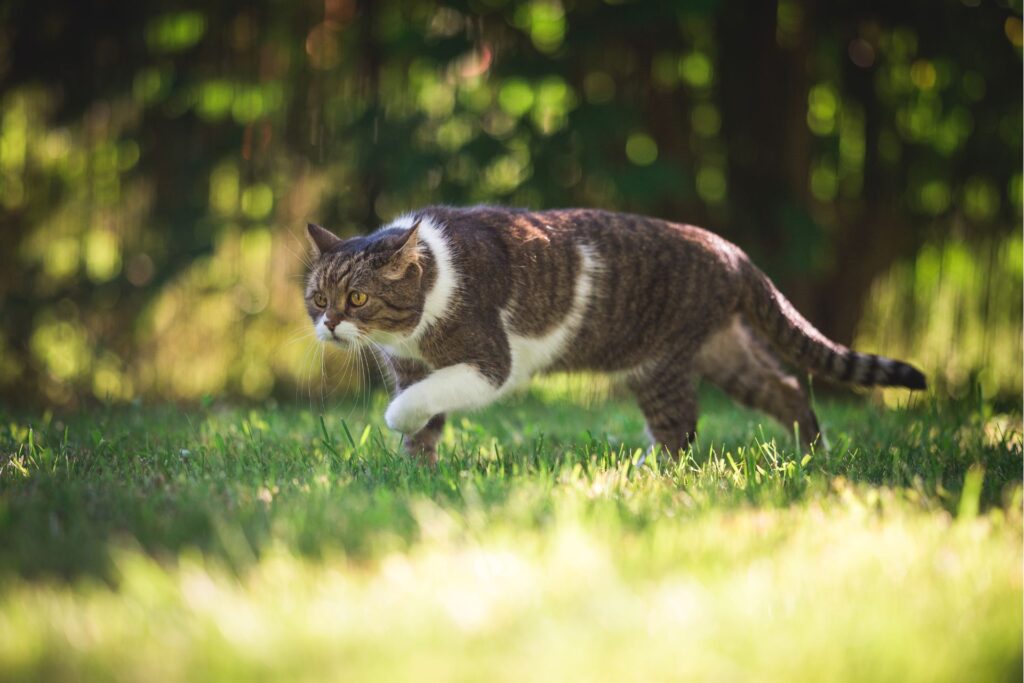
Community And Neighbor Considerations
Talking to Neighbors
When it comes to managing neighborhood gardens and dealing with cats, open and friendly communication with your neighbors is crucial. Start by initiating a polite conversation with your neighbors about their cats. Here are some tips for having a constructive discussion:
1. Choose the Right Time: Approach your neighbors when they seem relaxed and open to conversation. Avoid times when they might be in a hurry or stressed.
2. Be Respectful: Express your concerns in a non-confrontational manner. Use “I” statements to convey how the cats are affecting your garden. For example, “I’ve noticed that the cats have been digging in my garden, and it’s been challenging for me.”
3. Listen Actively: Give your neighbors a chance to respond. They may not be aware of the issue and could be more willing to help if they understand the problem.
4. Propose Solutions: Suggest cooperative measures that can benefit everyone. For instance, discuss ways to keep the cats away from all neighborhood gardens, such as using natural repellents or creating designated cat-friendly areas.
Working together with your neighbors can lead to more effective and harmonious solutions, ensuring that all gardens in the community remain beautiful and cat-free.
Community Efforts
In addition to individual conversations, community-wide efforts can be incredibly effective in addressing the issue of cats in gardens. Here are some strategies to consider:
1. Community Gardens and Shared Deterrent Methods: Creating community gardens can foster a sense of collective responsibility and pride. These gardens can implement shared deterrent methods, such as installing motion-activated sprinklers or using plant-based repellents that are safe for both the cats and the environment. Sharing the responsibility and costs of these deterrents can make them more accessible and effective.
2. Local Ordinances and Support from Animal Control: Check with your local government to understand any ordinances related to pet control and outdoor cats. Some communities have specific rules about pets roaming freely. Additionally, animal control services can offer support and guidance on humane ways to manage outdoor cats. They might provide resources such as traps for catch-and-release programs or advice on preventing stray cats from becoming a nuisance.
By engaging with your community and leveraging local resources, you can create a comprehensive approach to keeping gardens safe from cats. These collective efforts not only protect your garden but also strengthen community bonds and promote a more enjoyable living environment for everyone.
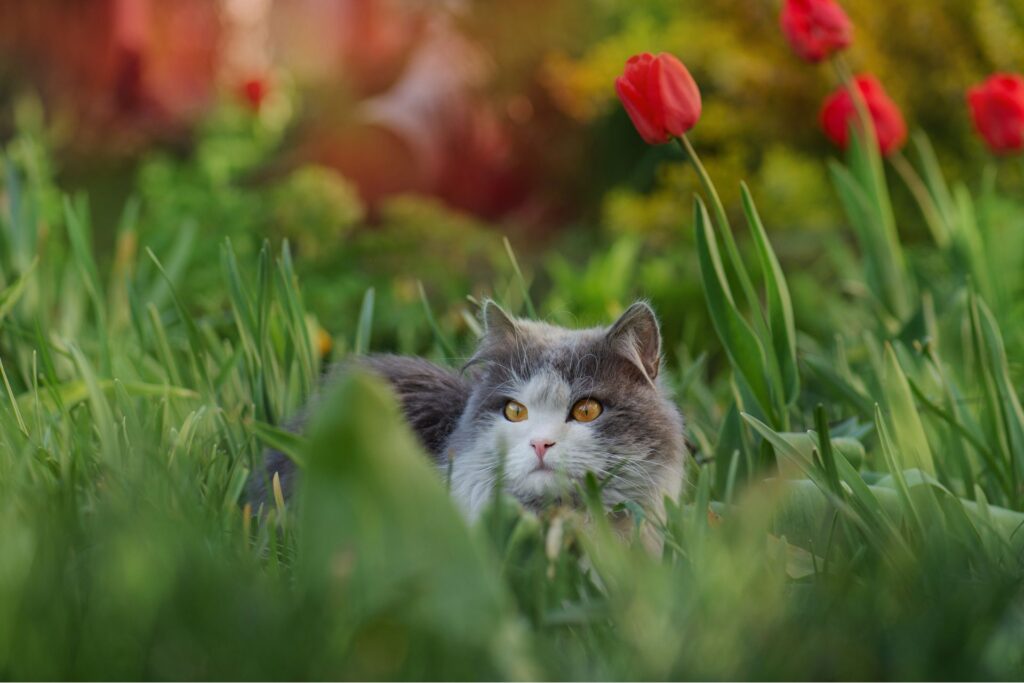
Maintenance And Consistency
Regular Monitoring
One of the cornerstones of maintaining a cat-proof garden is regular monitoring. Frequent checks of your garden are essential for several reasons. First, they allow you to identify any new entry points that cats might have discovered. Cats are incredibly agile and persistent creatures, often finding weaknesses in your barriers or discovering new routes to access your garden. By inspecting your garden regularly, you can spot these issues early and take corrective action before they become significant problems.
Moreover, regular monitoring helps you evaluate the effectiveness of your current deterrent strategies. Are the plants you’ve chosen thriving and doing their job? Are the scent-based repellents still potent? Is there any evidence that cats have been breaching your defenses? By staying vigilant and proactive, you can make necessary adjustments to your strategies, ensuring they remain effective. This might mean replacing worn-out deterrents, reapplying repellents, or even trying out new methods to keep the cats at bay.
Ongoing Deterrents
Ensuring that your deterrents remain effective over time is another critical aspect of maintaining a cat-proof garden. Cats are known for their ability to adapt, and what might have been an effective deterrent initially could lose its impact as cats become accustomed to it. This is why it’s crucial to keep your deterrents ongoing and varied.
One effective approach is to rotate your deterrent methods. For instance, if you’ve been using a certain type of scent repellent, switch it out for a different one after a few weeks. Similarly, if you’ve set up physical barriers, consider altering their arrangement periodically. This rotation keeps the cats from getting too comfortable and finding ways around your defenses.
Additionally, ensure that any physical deterrents, such as fences or netting, are maintained in good condition. Regularly check for and repair any damage that could allow cats to sneak through. If you’re using motion-activated sprinklers or ultrasonic devices, test them periodically to confirm they’re working correctly.
By combining regular monitoring and ongoing deterrents, you create a dynamic defense system that continually adapts to keep your garden cat-free. This approach not only protects your plants and landscaping efforts but also ensures a harmonious environment where both you and your garden can thrive. Maintaining this level of consistency might seem labor-intensive, but the results—a beautiful, cat-free garden—are well worth the effort.
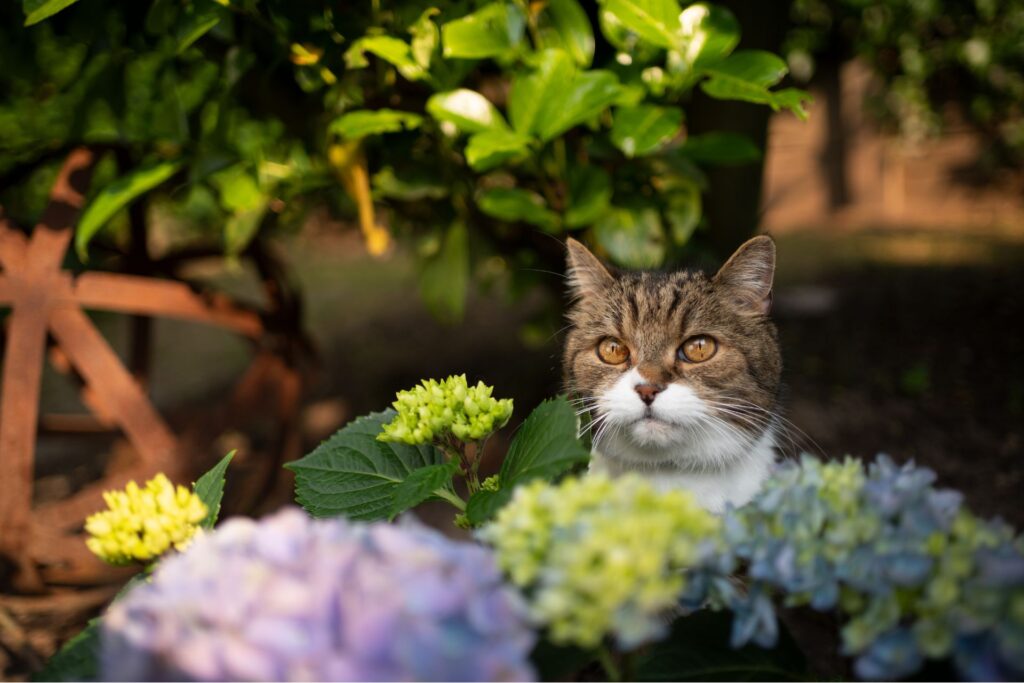
FAQs: About How To Keep Cats Out Of Your Garden
Conclusion
In conclusion, this article has explored the various aspects of retaining walls in New Zealand, covering their types, benefits, and costs, as well as the essential factors to consider when building one. Building a retaining wall can be a complex process, but with patience and persistence, it can also be a rewarding endeavor that enhances both the functionality and aesthetics of your property. We encourage you to remain diligent throughout the planning and construction phases to ensure a durable and effective structure. Finally, we invite you to share your own tips and experiences in the comments section below, as your insights could be invaluable to others embarking on similar projects.
About the Author:
Mike Veail is a recognized digital marketing expert with over 6 years of experience in helping tradespeople and small businesses thrive online. A former quantity surveyor, Mike combines deep industry knowledge with hands-on expertise in SEO and Google Ads. His marketing strategies are tailored to the specific needs of the trades sector, helping businesses increase visibility and generate more leads through proven, ethical methods.
Mike has successfully partnered with numerous companies, establishing a track record of delivering measurable results. His work has been featured across various platforms that showcase his expertise in lead generation and online marketing for the trades sector.
Learn more about Mike's experience and services at https://theleadguy.online or follow him on social media:

